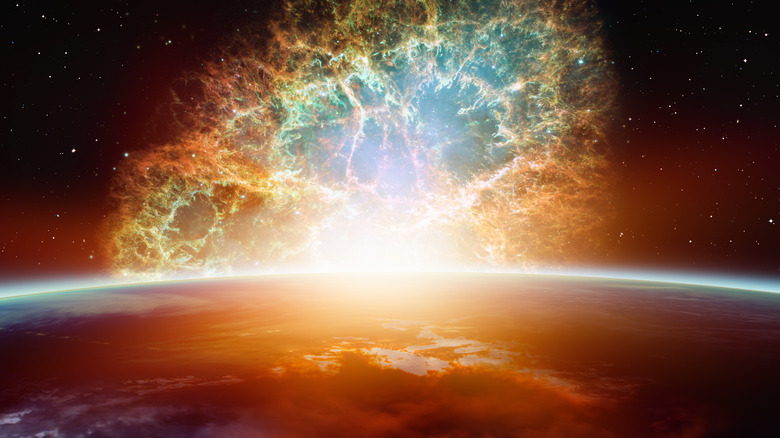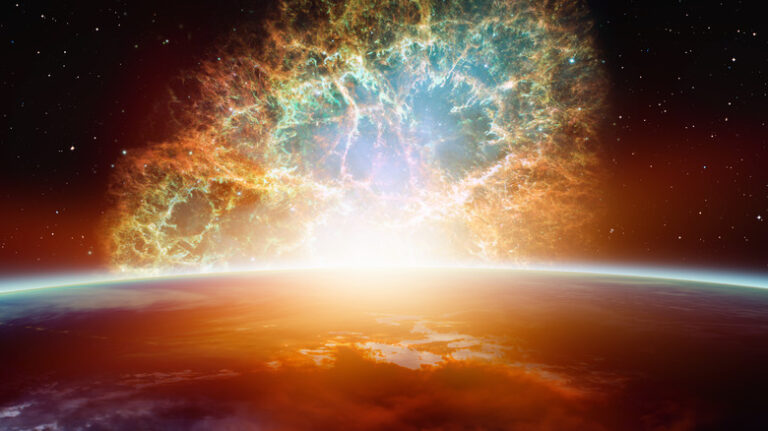Here are several factors that make supernovae the universe’s most intense explosions.
The cosmos that can be seen is very large. Like, 93 billion light years across; extremely, really vast (via Futurism). To put it into perspective, imagine jogging that distance 834 billion times, followed by 25 billion back-to-back marathons. Though you would still have a ways to go—roughly 477 quintillion miles—you would be more than 99.9% finished by that point. Mind you, that’s just the observable universe. According to scientists, the entire cosmos is more than 250 times larger (via MIT Technology Review). NASA claims that supernovae are responsible for the largest explosions that have ever been seen by humanity in all of that space, among all of those innumerable points of light.

There are essentially two sorts of supernovae. When two stars are circling one another and one of them effectively consumes the other, a Type I supernova results. Supernovae of type II are the last moments of massive solitary stars. Fortunately, Sol, also known as Earth’s star or what we prefer to refer to as the sun, has no partner stars and has a mass that is around eight times too low to undergo a Type II supernova. Despite this, Sol will still engulf Earth in a few billion years, but that is a topic for another article.
A star that goes supernova may outglow a whole galaxy of billions of stars for months while also creating a black hole (via Nature). Because of their strength, these explosions have the ability to sterilise every planet within a hundred trillion kilometers. Those pyrotechnics are quite impressive.
How do they cram all the blam?

It’s essential to comprehend how stars function in order to comprehend where supernovae derive all of their strength. They start off as enormous balls of blazing gas, often hydrogen, the element with the highest abundance. Because stars are so big, their gravitational attraction causes the hydrogen at their centers to be compressed until it fuses into helium. The same kind of fusion energy is being sought after by scientists as a clean energy source for use on Earth.
According to a presentation from Caltech, the star’s gravity is resisted by the heat and light produced by fusion in the star’s core. In a momentary equilibrium, the opposing interior and outer forces balance each other out. Over time, helium accumulates in the star’s core, interfering with the fusion reaction and upsetting the delicate equilibrium.
Unless they have a nearby partner they may steal material from till they reach a runaway nuclear reaction (through Space), which is a term that, when used to describe an entire star, results in a Type Ia supernova, smaller stars halt here and progressively cool into the long future. When the fusion processes in bigger stars stop counteracting gravity, they begin burning their helium into ever heavier elements (via Stanford). A Type II supernova occurs when the entire star collapses on itself in a couple of seconds before violently exploding back into space. Should we be concerned, though, with a supernova going off every ten seconds?
Should you be looking at supernova insurance?
You may relax, at least in terms of supernovae, according to the wonderful video from Kurzgesagt above. In a sense, supernovae are responsible for our solar system’s formation since it was contained within a bubble left behind by one of these early explosions. You wouldn’t be here without supernovae, according to a 2019 assessment in the journal “Science,” since many of the elements that make up your body — including oxygen, sodium, calcium, and others — were created inside of and spread during catastrophic supernova detonations.
In the case of supernovae, being too near might be considered to be having too much of a good thing. According to a 2020 paper published in “Proceedings of the National Academy of Sciences,” the “kill zone” around a supernova is approximately 33 lightyears across, and such an explosion at a distance roughly twice that may have caused a significant extinction event on Earth about 350 million years ago.
According to ESA observations, a supernova explodes within the Milky Way galaxy around every 50 years or so. We have lots of breathing room because the Milky Way, while only a small blip in the vastness of space, is yet enormous on a human scale. Only a few number of stars are close enough to Earth that their supernovae will endanger life as we know it. Scientists do not anticipate these stars going supernova any time soon.
Do not forget to share your opinion with us to provide you with the best posts !




0 Comments